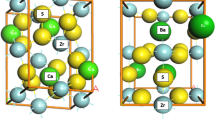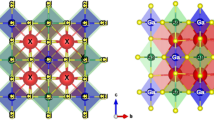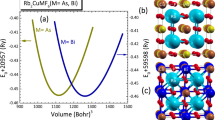Abstract
ReflectivityR(λ) in infrared spectral region was measured on bismuth selenide crystals Bi2Se3(Cu) doped with copper and on the crystals Bi2Se3(2Cu+3Se) doped with copper and selenium in atomic ratio 2:3. Bi2Se3(Cu) crystals exhibit a pronounced shift of the reflectivity minimum towards shorter wavelengths, as compared with “pure” Bi2Se3, whereas in the Bi2Se3(2Cu+3Se) crystals the reflectivity minimum is shifted towards longer wavelengths, as compared with “pure” Bi2Se3 crystals.
Hall constant and theN/m χ ratio, calculated from the reflectivity curves in the plasma resonance frequency region, were determined for “pure” Bi2Se3. Assuming the “single valley” model to hold for the conduction band of Bi2Se3, we calculated the effective mass of free current carriers:m χ=m ⊥c =0.13m 0. On the assumption thatm ⊥c is constant in a moderately broad range of free-carrier concentrations we then calculate the free carrier concentrations in Bi2Se3(Cu) and Bi2Se3(2Cu+3Se) and correlate them with the concentrations of copper, as determined by a chemical analysis. Discussion of possible point defects introduced by building of Cu atoms into the Bi2Se3 lattice leads to the conclusion that in Bi2Se3(Cu) crystals copper exist in the form of singly ionized interstitial atoms Cu + i which act as donors, whereas in Bi2Se3(2Cu+3Se) crystals there arise most probably substitutional defects of copper on bismuth sites, CuBi″, which carry double negative charge and act as acceptors.
Similar content being viewed by others
References
H. Gobrecht, S. Seeck, T. Klose: Z. Physik190, 427 (1966)
P. P. Konorov: Z. Techn. Fiz.26, 1394 (1956)
V. F. Boechko, V. I. Psarev: Fiz. i. Techn. Poluprovod.6, 2042 (1972)
L. P. Caywood, G. R. Miller: Phys. Rev. (B)2, 3209 (1970)
A. Vaško: Exper. Techn. Phys.12, 392 (1964)
I. F. Bogatyrev, J. Horák, A. Vaško, L. Tichý: Czech. J. Phys. B23, 1111 (1973)
H. Gobrecht, S. Seeck: Z. Physik222, 93 (1964)
H. Köhler, G. Landwehr: Phys. Stat. Sol. (b)45, K 109 (1971)
H. Krebs:Grundzüge der Anorganischen Kristallchemie (F. Enke Verlag, Stuttgart 1968) p. 239
H. Gobrecht, K. E. Boeters, G. Pantzer: Z. Physik177, 68 (1964)
Author information
Authors and Affiliations
Rights and permissions
About this article
Cite this article
Vaško, A., Tichý, L., Horák, J. et al. Amphoteric nature of copper impurities in Bi2Se3 crystals. Appl. Phys. 5, 217–221 (1974). https://doi.org/10.1007/BF00928132
Received:
Accepted:
Issue Date:
DOI: https://doi.org/10.1007/BF00928132




